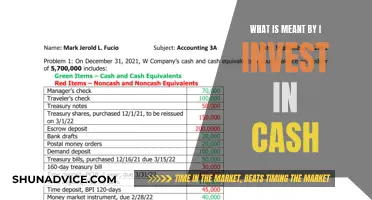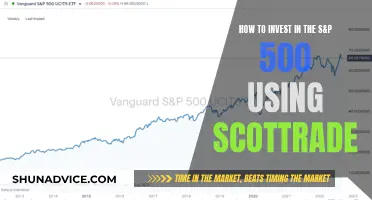
Benchmarks are a crucial tool for investors to measure the performance of their portfolios. A benchmark is a standard or measure used to analyse the allocation, risk and return of a portfolio. It is often a market index or a combination of indexes that track the performance of a broad asset class or a narrow slice of the market. Investors can use benchmarks to understand how their portfolio is performing against various market segments.
There are several popular benchmarks that investors use, including the S&P 500, Dow Jones Industrial Average, Russell 2000, and Bloomberg U.S. Aggregate Bond Index. These indexes provide a reference point for investors to compare the performance of their portfolios and make more informed investment decisions.
When choosing a benchmark, it is important to select one that is relevant to your specific investment strategy and risk tolerance. Additionally, investors should consider the limitations of benchmarks, as they are based on past performance and may not accurately predict future results.
| Characteristics | Values |
|---|---|
| Purpose | Measure the change in an asset's value or another metric over time |
| Type | Standard or measure |
| Use | Reference point for the performance of securities, mutual funds, exchange-traded funds, portfolios, or other financial instruments |
| Creation | Created by institutions such as Standard & Poor's, Russell, and MSCI |
| Composition | Combination of indexes that investors and portfolio managers use to measure an investment portfolio's performance |
| Selection Criteria | Overall performance goals, tolerance for volatility or risk, need for liquidity, investment in international securities, liabilities linked to inflation, range of securities in the portfolio |
| Examples | S&P 500, Dow Jones Industrial Average, Russell 2000, Bloomberg U.S. Aggregate Bond Index, Vanguard S&P 500 ETF |
What You'll Learn

How to choose a benchmark
Benchmarks are important in investing as they provide a standard or measure to analyse the allocation, risk and return of a given portfolio. They are typically market indexes or a combination of indexes that investors and portfolio managers use to measure an investment portfolio's performance.
When choosing a benchmark, it is important to consider the following:
- Risk and return goals: Before selecting a benchmark, investors should evaluate their return goals and risk tolerance. If an investor has a low-risk tolerance, they will likely select an index with a shorter duration or higher credit quality. On the other hand, an investor looking for high returns may opt for an index with a history of high long-term returns, even if it exhibits performance volatility and the possibility of negative returns over shorter periods.
- Liquidity needs: An investor looking to invest operating cash to meet short-term liabilities will require a highly liquid portfolio and would thus choose an index with a very short duration. They would want to avoid riskier benchmarks that contain less liquid securities.
- International investments: Global securities can serve different purposes depending on whether the foreign currency exposure is hedged or unhedged. An investor who wants to take a position on currency by investing in foreign holdings would use an unhedged index, whereas those seeking capital preservation would opt for indexes that hedge currency risk.
- Inflation-linked liabilities: Rising inflation levels can erode the real returns on an investment. Investors with inflation-linked liabilities may choose a benchmark that tracks the performance of specific investments that tend to benefit from inflation, such as real estate or commodities.
- Range of securities: A benchmark should be a "good fit" for the range of securities in which the portfolio manager can invest. A broad investment universe can help increase returns and reduce volatility. However, if the benchmark is too narrow, it may be challenging for the investment manager to make noticeable contributions to the portfolio's performance through active management.
- Minimum standards: When selecting a specific benchmark, investors should consider minimum standards such as unambiguous and transparent security names and weights, investability, daily pricing, availability of historical data, low turnover, specification in advance, and published risk characteristics.
It is also important to remember that benchmarks are indicators of past performance and do not guarantee future results. Therefore, it is recommended to make comparisons over longer periods of time, such as several years, rather than shorter periods that may be skewed by one-time events.
Invest Using GCash: A Beginner's Guide to Getting Started
You may want to see also

Benchmarks for different investment types
Benchmarks are an essential tool for investors to measure and compare the performance of their investments. They provide a reference point to evaluate the effectiveness of investment strategies and make informed decisions.
There are several types of benchmarks that cater to different investment types and strategies. Here are some of the most common benchmarks for different investment types:
Equity Benchmarks
Equity benchmarks are used to measure the performance of stocks or equities. One of the most popular equity benchmarks is the S&P 500, which includes 500 of the largest U.S. publicly-traded companies. The Dow Jones Industrial Average is another well-known equity benchmark, comprising 30 U.S. blue-chip stocks from established and financially sound companies. These benchmarks are often used as a gauge for the overall stock market performance.
Fixed Income Benchmarks
Fixed-income benchmarks focus on measuring the performance of fixed-income assets such as bonds and treasuries. The Bloomberg Aggregate Bond Index (Agg), the Bloomberg U.S. Corporate High Yield Bond Index, and the Bloomberg U.S. Treasury Bond Index are examples of top fixed-income benchmarks. These indexes are used by investors to generate income or preserve capital during market downturns.
Commodity Benchmarks
Commodity benchmarks track the performance of a basket of commodities. For instance, the Bloomberg Commodity Index (BCOM) includes 23 exchange-traded physical commodities futures across five sectors. Commodity benchmarks provide investors with insights into the performance of the commodities market and its various sectors.
International Benchmarks
International benchmarks, such as the MSCI World Index, offer a broader perspective by providing insights into global market trends beyond an investor's domestic market. These benchmarks are particularly useful for investors with a global investment portfolio or those interested in international market performance.
Custom Benchmarks
Custom benchmarks are tailored to align with specific investment strategies or objectives. They are designed to provide a more nuanced evaluation of niche or specialised investment approaches that may not be adequately covered by standard benchmarks.
Exchange-Traded Funds (ETFs) as Benchmarks
ETFs are also increasingly being used as benchmarks. These investment vehicles replicate the performance of a particular index, sector, or commodity. ETFs offer a real-time reflection of market dynamics and can be useful for investors with specialised investment focuses.
It is important to note that the selection of an appropriate benchmark is crucial. Investors should choose benchmarks that align with their investment objectives, risk tolerance, asset allocation, and investment strategies. Benchmarks provide valuable insights, but they should be used in conjunction with individual investment goals for effective decision-making.
Investing via Cash App: A Guide for Under-18s
You may want to see also

Benchmarks for different markets
Benchmarks are an important tool for investors to compare their portfolio's performance against a reliable metric. They are used as a reference point for the performance of securities, mutual funds, exchange-traded funds (ETFs), and other financial instruments.
Equities Market
The S&P 500 and Dow Jones Industrial Average are two of the most popular large-capitalization stock benchmarks in the equities market. The S&P 500 includes 500 of the largest US publicly-traded companies and is considered the most widely used benchmark for equities. The Dow Jones Industrial Average, on the other hand, comprises 30 well-recognized and financially sound US companies.
Other popular benchmarks in the equities market include the Vanguard S&P 500 ETF, iShares MSCI ACWI ETF, and the Russell 2000.
Fixed Income Market
Fixed income indexes measure the performance of fixed-income assets like bonds and treasuries, which are used by investors to generate income or preserve capital during market downturns.
Some of the top fixed-income benchmarks include the Bloomberg Aggregate Bond Index (Agg), the Bloomberg U.S. Corporate High Yield Bond Index, and the Bloomberg U.S. Treasury Bond Index. The Agg is widely used by bond traders, mutual funds, and ETFs as a benchmark for the relative performance of the bond or fixed-income market.
Commodity Market
Commodity indexes measure the performance of a basket of commodities. The Bloomberg Commodity Index (BCOM) is an example of a broad-market commodity index that consists of 23 exchange-traded physical commodities futures across five sectors.
Cryptocurrency Market
Even the cryptocurrency market has benchmarks, highlighting the importance of comparing an asset's performance to a standard.
International Market
International investors may use the MSCI Indexes as a benchmark.
Projecting Future Cash Flows: A Guide to Investment Projections
You may want to see also

Benchmarks for different risk tolerances
Benchmarks are standards used to measure the change in an asset's value over time. They are important because they allow investors to compare their holdings' performance against reliable metrics.
There are different benchmarks for different risk tolerances. Risk tolerance is the degree of risk that an investor is willing to endure given the volatility in the value of an investment. It often determines the type and amount of investments that an individual chooses.
Aggressive Risk Tolerance
Investors with aggressive risk tolerance don't shy away from volatile assets and are willing to risk losing money to get potentially better results. They tend to be market-savvy and follow strategies for achieving higher-than-average returns. Their investments emphasize capital appreciation rather than income or preserving their principal investment. This investor's asset allocation commonly includes stocks and little or no allocation to bonds or cash. Examples of benchmarks for aggressive risk-tolerant investors include the S&P 500, Dow Jones Industrial Average, and the Russell 2000.
Moderate Risk Tolerance
Investors with moderate risk tolerance want to grow their money without losing too much. Their goal is to weigh opportunities and risks, and their approach is sometimes described as a "balanced" strategy. They commonly develop a portfolio that includes a mixture of stocks and bonds, such as a 50/60 or 60/40 structure. The 60/40 portfolio has long been a benchmark for investors with moderate risk tolerance.
Conservative Risk Tolerance
Conservative investors are willing to accept little to no volatility in their investment portfolios. They commonly seek investments with guaranteed returns and are often retirees or those close to retirement age. They target vehicles that are guaranteed and highly liquid, such as bank certificates of deposit (CDs), money markets, or U.S. Treasuries for income and preservation of capital.
It's important to note that risk tolerance can vary depending on age, investment goals, income, and other factors. Additionally, benchmarks are not a perfect indicator of future performance, as they are based on past performance.
Unlocking Cash Flow Secrets for Smart Investments
You may want to see also

How to use benchmarks
Benchmarks are a crucial tool in investing. They are typically market indexes or a combination of indexes that investors use to measure the performance of their portfolios.
- Understand what a benchmark is: A benchmark is a standard or measure used to analyse the allocation, risk and return of a portfolio. It is a reference point for the performance of securities, mutual funds, exchange-traded funds, portfolios or other financial instruments.
- Know the different types of benchmarks: There are benchmarks for every type of investment and strategy. Broad market and market-segment stock and bond indexes are commonly used. Fixed-income indexes, such as the Bloomberg U.S. Aggregate Bond Index, are used to measure the performance of fixed-income assets like bonds and treasuries. Commodity indexes, such as the Bloomberg Commodity Index, measure the performance of a basket of commodities.
- Choose the right benchmark for your portfolio: With so many benchmarks to choose from, it's important to select one that aligns with your investment strategy and goals. Consider your risk tolerance, return goals, need for liquidity, investment time horizon and international exposure. For example, if you have a diversified portfolio, you may need to evaluate it in sections.
- Compare your portfolio performance: Use benchmarks to compare the performance of your portfolio to relevant indexes. This will help you understand if your portfolio is meeting your investment goals and how it is performing relative to the market. You can use tools like Sharesight's benchmarking feature to track your portfolio's success.
- Evaluate fund performance: Weigh the return on your investments against comparable benchmarks to make more informed decisions. If a fund consistently lags its benchmark, you may need to reconsider if it is the best fit for your portfolio. However, also consider the level of risk your investment is assuming relative to the benchmark.
- Monitor your portfolio: Use benchmarks and risk metrics to monitor your portfolio within the macro investing environment. Markets can shift due to various factors, and active investors who use benchmarking analysis techniques can capitalise on evolving investment opportunities.
- Customise your benchmarks: While standard benchmarks are useful, you can also create custom benchmarks that represent the exact index weightings and strategy components of your specific portfolio. This allows for a more accurate comparison of your portfolio's performance.
Invest Cash, Avoid FAFSA: Strategies for Financial Aid Freedom
You may want to see also
Frequently asked questions
A benchmark is a standard or measure used to analyse the allocation, risk and return of a given portfolio. It is often a market index, or combination of indexes, that investors and portfolio managers use to measure an investment portfolio's performance.
Benchmarks allow investors to gauge the relative performance of their portfolios. They are important because they allow investors to compare their holdings' performance against reliable metrics.
With a vast number of benchmarks to choose from, deciding which one, or which combination of indexes to use, can be challenging. It is important to choose the appropriate benchmark as a point of comparison. For instance, if you’re evaluating a large-capitalization U.S. stock mutual fund, then the S&P 500 could be a relevant benchmark.
Some popular benchmarks include the S&P 500, Dow Jones Industrial Average, Russell 2000, Bloomberg U.S. Aggregate Bond Index, and the S&P Municipal Bond Index.







